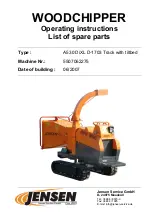
Installation, Start-Up, Adjustment and Maintenance Manual
45
•
CAN-BUS wire connection to Electronic Control board
Figure 22 –
EXAMPLE OF CAN-BUS CONNECTION TO ELECTRONIC CONTROL BOARD (EXAMPLE WITH ONLY
ONE CAN-BUS WIRE)
To connect a CAN bus cable to an appliance:
You will need:
The appliance (or appliances) positioned in its (or their) final location.
Before working on the electrical panel of the appliance, make sure that it is not connected to the
power supply.
1.
Remove the front panel of the appliance and the cover of the electrical panel.
2.
Cut the ideal length of cable for the installation so that it will not undergo bending.
3.
Having chosen one end of the length of cable, remove the sheath from a length of approximately 70-
80 mm, taking care not to cut the shielding (metallic shield and/or aluminium sheet and, if present, the
bare connector in contact with the shield) and the wires contained within.
4.
If the diameter of the cable used is not large enough to be blocked inside the cable clamp (letter C of
Figure 22
on page 45), make it larger by wrapping electrical tape over the protective outer covering in
the area adjacent to the unsheathed part (approximate diameter required: 12-13 mm).
5.
Pull back the shielding in the sheathe; apply electrician’s tape to the end of the shielding as pulled
back (letter A of
Figure 22
, page 45).
6.
If the appliance is a
terminal node
of the network connect the three coloured wires to the orange
connector, as shown in detail A; of Figure 23 on page 46. Respect the correct indications L, H, GND
provided in
Table 17
on page 44, on the figure and on the diagram at the base of the connector.
7.
If the appliance is an
intermediate node
repeat the operations from step 3 to step 6 for the other
length of cable required (so to will have two cable lengths everyone without the sheath). To interlace
between they the threads with the same color and to connect them to the orange connector, as shown
in detail B; of Figure 24 on page 46.
8.
Fix the CAN bus cable (or two cables, according to the type of node being connected) to the cable
fixing bracket in the upper part of the inside of the electrical panel so that the rolled-back sheathing
makes solid contact with the metal bracket. The cables must be held firmly in place by the bracket if
pulled..
LEGEND
NB: Situation with only one CAN-BUS wire
(The figure at left, is an example of
terminal node
connection to electronic control board).
A
Isolated adhesive tape
B
CAN-BUS wire shield
C
Fixing clamp
(1 CAN-BUS wire is fixed)
D
Connector for CAN-BUS wire conductors
(to be removed to ease the conductors connection)
E
Internal conductors (n. 3) of CAN-BUS wire
F
Fixing point for eventual 2° segments CAN-BUS wire
(
intermediate node
)
B
C
E
D
A
F
















































